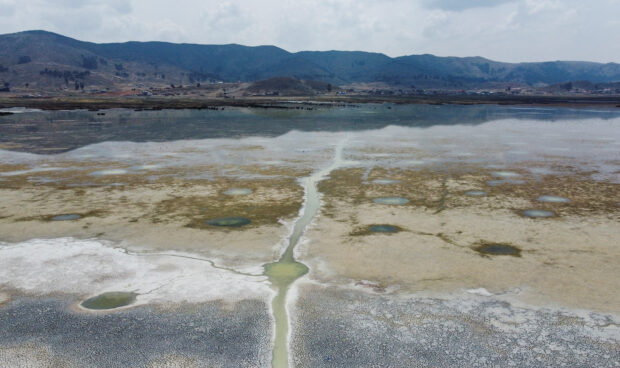In South America’s Andes, a shrinking Lake Titicaca rings climate alarm bell

Alex Flores walks on a dry area of Lake Titicaca, Latin America’s largest freshwater basin, as it is edging towards record low levels, on Cojata Island, Bolivia October 26, 2023. REUTERS/Claudia Morales/File Photo
COJATA, Bolivia — The exposed cracked floors of parts of Lake Titicaca, South America’s largest body of fresh water and the highest navigable lake in the world nestled amid the Andes mountains, are an alarming sight for local farmer Manuel Flores.
His crops are parched, nearby water wells have dried up amid a long spell of drought, and his livestock are struggling. Like many who live on or around the lake, he used to get around easily by boat. Now he walks across the dried-up lake bed.
The lake, once seen as a deity by the pre-Columbian people that lived on its shores, is an important ecosystem for wildlife and a water source for millions of people, including in the city of El Alto, some 40 kilometers (25 miles) to the east.
But its water levels are now reaching record lows, worsened by the El Nino weather phenomenon that means less rain in the area, compounding a long dry spell and rare high temperatures.
Scientists say such extreme weather is becoming increasingly common globally because of climate change, which also intensifies the effects of El Nino.
Article continues after this advertisement“I am 50 years old. Never before has Lake Titicaca dried up like it is now. This affects us, because there is no more food for our livestock and we cannot travel by boat,” said farmer Flores. “Now we have to walk and our crops no longer exist because it hasn’t rained since last year.”
Article continues after this advertisementThe drought is approaching critical levels for the region’s agriculture, farmers and experts said. If it does not rain by early December there will be no planting of potatoes, one of the food staples for Bolivia’s rural communities and cities.
Around the lake, especially in the smaller and shallower “Lago Menor,” the waters have receded from the shoreline, partly due to the lack of rains, high temperatures and receding of the Andean glaciers, whose melt water normally feeds the lake.
Experts say many of the factors contributing to the shrinking of Lake Titicaca could be linked to climate change.
“Ninety-five percent of the water loss from the lake is due to evaporation, which shows that this is totally or almost totally caused by climate change,” said Xavier Lazzaro, an aquatic systems specialist with French research institute IRD.

Partial view of Lake Titicaca, Latin America’s largest freshwater basin, as it is edging towards record low levels, on Cojata Island, Bolivia October 26, 2023. REUTERS/Claudia Morales/File Photo
‘Going down centimeter by centimeter’
According to MapBiomas Agua, which has monitored changes in surface water bodies in the area for two decades, Bolivia overall has seen a 39% drop in its natural surface waters, such as rivers and lagoons, between 1985 and 2022.
The decline comes with global temperatures hitting record highs, which has impacted rivers, lakes and glaciers from the United States to Asia.
“There are many factors, many causes,” said Rodney Camargo, an official at local NGO Friends of Nature Foundation (FAN).
“On one hand we have local causes that we know about: deforestation, fires, human activity, large dams, which have an effect. In global terms we have climate change, and phenomena such as El Nino and La Nina, which cause floods and droughts.”
Back at Lake Titicaca, Fredy Aruquipa, the person in charge of monitoring the lake’s water level, watches it decline daily.
“The water is going down centimeter by centimeter,” he said.